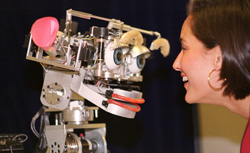A Q&A With Cynthia Breazeal
The director of MIT's Personal Robots Group on designing robots that will be useful in our everyday lives.
What makes your robots different from traditional robots?
It's all about human-robot interaction in this more interpersonal sense, like you saw in Star Wars. Until then, the way we reacted with robots was [by] remote control or button pushing. Now, the robot becomes almost more like a creature you interact with, like a person or a companion animal. That was a totally different paradigm. People hadn't really seriously looked at that, particularly when you talk about the social and emotional component. It's really fascinating to get into this human psychology as much as the artificial intelligence of the robot to make that partnership work. A lot of our technology is about, here's information, here's data. It's treating people as purely cognitive processing beings, and yes, we do this. But we're a lot more than that.
How are your "social robots" going to be useful in our everyday lives?
It turns out that these social robots can tap into all these dimensions, and when you do that you can imagine applications for robots that are very different from the robot automaton that is going to clean our house. Health and learning are domains where we know that information alone isn't sufficient. Because we're so profoundly social, these robots can help us help ourselves to achieve these goals along other dimensions, whether they're health goals or behavior change goals. It's very exciting because it's a very different way of thinking about interacting with technology that's much more humanized and that taps into our human selves—that allows us to feel more like people when we interact with technologies, versus this big criticism of [how] technology dehumanizes us. It's really trying to say, we want to create technologies that support our humanity in the best possible way.
A lot of your work is on robots specifically designed for kids. Why does that area interest you?
Kids love robots. They're this fanciful, cool thing. … [But] I want to make sure kids get a lot of play time in the social/physical world, and so I have a lot of projects thinking about that. These robots might also help with early literacy, second-language learning. More and more kids are coming in [to school] speaking English as a second language, but the best time to learn a language is [when you're] as young as possible. Your brain changes. If you can bring those language learning experiences to kids before they're 7, that's the perfect time. I'm really intrigued by the idea of robots as second-language-learning companions.
Will any of your projects be on the market in the near future?
We did a project in 2004 that is getting commercialized that is essentially a robot weight-loss coach. We found that people bonded with the robot, trust the robot more, [and] interacted with the robot more than a computer that gave the same advice or a pure data-driven log book.
Return to Breazeal's profile.
Watch Breazeal's recent TED talk and see videos of her robots in action.
Check out the rest of our technology Top Right:
Jeff Bezos, founder and CEO of Amazon.com.
David Ferrucci, lead researcher for IBM's Watson project.
Salman Khan, founder of Khan Academy.
Brian Tucker, president of GeoHazards International.


